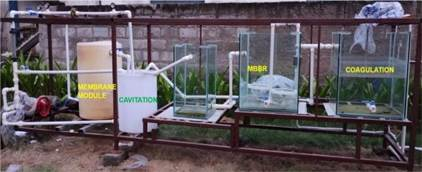Important Facts For Prelims
Textile Wastewater Treatment Plant
- 24 Jun 2023
- 7 min read
Why in News?
In a collaborative effort, NIT Warangal, Prime Textiles, and IMPRINT have developed an eco-friendly solution to treat wastewater in the textile and apparel industry located in Hanumakonda district, Telangana, through a pilot-scale textile effluent treatment plant.
- This innovative technology holds immense potential for transforming toxic wastewater into a valuable irrigation source for nearby agricultural areas, while also offering a sustainable alternative to existing treatment methods.
Why is Efficient Treatment of Textile Effluent Necessary?
- Textile effluent contains high levels of pollutants such as dyes, dissolved solids, suspended solids, and toxic metals.
- Robust and efficient technologies are essential to treat this effluent before it is discharged into the environment.
How Does this Innovative Technology Work?
- The innovative technology developed for treating textile wastewater combines biosurfactants, cavitation, and membrane technologies.
- Biosurfactants:
- Biosurfactants are natural compounds produced by microorganisms, and they possess surface-active properties.
- In the textile effluent treatment plant, biosurfactants are used in the Moving Bed Biofilm Reactor (MBBR) to aid in the removal of dyes from the wastewater.
- The use of biosurfactants in the MBBR not only improves the efficiency of dye removal but also reduces operational time and cost compared to other biological treatment methods.
- Cavitation:
- Cavitation is an advanced oxidation process (AOP) utilized in the treatment plant.
- It involves the creation of pressure variations in a liquid, leading to the formation and implosion of countless small cavities.
- The cavitation phenomenon helps destroy various pollutants in the wastewater, generating oxidizing radicals in-situ, which play a crucial role in the degradation of pollutants.
- This process contributes to reducing installation costs and the carbon footprint of the treatment plant.
- Membrane Technology:
- Membrane technology is employed in the textile effluent treatment plant to enhance the separation and removal of pollutants.
- The membrane's surface is modified using a sol-gel process with boehmite sol, which reduces the pore size from micro-scale to nano-scale.
- This modification significantly improves the membrane's performance by effectively separating and trapping pollutants, leading to cleaner treated water.
- Biosurfactants:
- Overall Treatment Process:
- The overall treatment process involves coagulation to remove suspended solids' turbidity, biofilm growth in MBBR for heavy metal reduction and degradation of biodegradable pollutants, cavitation for pollutant destruction and energy generation, and the use of surface-modified membranes for efficient pollutant separation.
- The pilot plant, with a capacity of 200 Litres Per Day, successfully treats the effluent for agricultural use and cleaning purposes.
UPSC Civil Services Examination, Previous Year Questions (PYQ)
Prelims
Q1. Biological Oxygen Demand (BOD) is a standard criterion for (2017)
(a) Measuring oxygen levels in blood
(b) Computing oxygen levels in forest ecosystems
(c) Pollution assay in aquatic ecosystems
(d) Assessing oxygen levels in high altitude regions
Ans: (c)
Exp:
- Biological Oxygen Demand (BOD) is the amount of Dissolved Oxygen needed by aerobic organisms to decompose organic material in a given sample of water at a certain temperature over a particular time period.
- BOD is one of the most common measures of pollutive organic material in water. BOD indicates the amount of putrescible organic matter present in water. Therefore, a low BOD is an indicator of good quality water, while a high BOD indicates polluted water.
- Sewage and untreated water discharge results in the decreased amount of Dissolved Oxygen as much of the available dissolved oxygen is consumed by aerobic bacteria in the degradation process, robbing other aquatic organisms of the Oxygen they need to live.
- Therefore, option C is the correct answer.
Q2. In the context of solving pollution problems, what is/are the advantage/advantages of bioremediation technique? (2017)
- It is a technique for cleaning up pollution by enhancing the same biodegradation process that occurs in nature.
- Any contaminant with heavy metals such as cadmium and lead can be readily and completely treated by bioremediation using microorganisms.
- Genetic engineering can be used to create microorganisms specifically designed for bioremediation.
Select the correct answer using the code given below:
(a) 1 only
(b) 2 and 3 only
(c) 1 and 3 only
(d) 1, 2 and 3
Ans: (c)
Exp:
- Bioremediation is a treatment process that uses naturally occurring microorganisms (yeast, fungi, or bacteria) to break down, or degrade, hazardous substances into less toxic or nontoxic substances.
- The microorganisms break down the organic contaminants into harmless products-mainly Carbon Dioxide and water. It is a cost effective, natural process applicable to many common organic wastes. Many bioremediation techniques can be conducted on-site. Hence, statement 1 is correct.
- All contaminants cannot be easily treated by bioremediation using microorganisms. For example, heavy metals such as Cadmium and Lead are not readily absorbed or captured by microorganisms. Hence, statement 2 is not correct.
- Genetic engineering can be used to create microorganisms designed for specific purposes for bioremediation. For example, Bacterium Deinococcus radiodurans (the most radioresistant organism known) has been modified to consume and digest Toluene and ionic Mercury from highly radioactive nuclear waste. Hence, statement 3 is correct.
- Therefore, option C is the correct answer.







